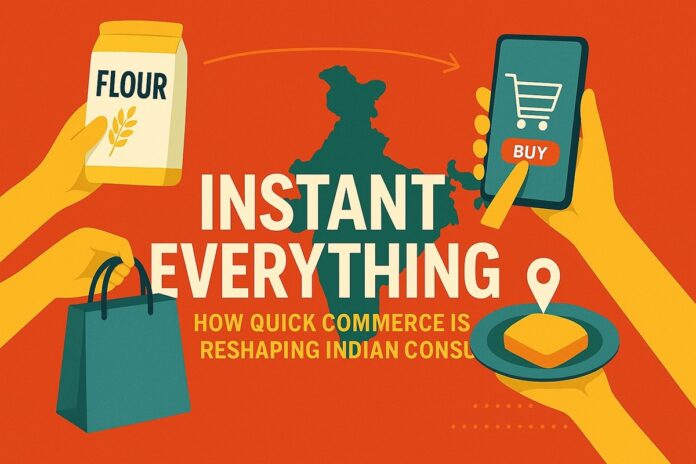By Akash Agrawalla – Co-Founder of ZOFF Foods
More than 60 million Indians now turn to quick commerce platforms for their everyday essentials, with urban orders skyrocketing by over 60% in the last year (RedSeer, 2024). In a country where time is a premium commodity, the demand for instant gratification has given rise to a retail revolution — Quick Commerce (Q-Commerce).
Built on the promise of 10–30 minute deliveries, Q-Commerce is transforming the way Indians shop. From groceries and medicines to late-night snacks and personal care essentials, the sector has reshaped consumer behavior, retail dynamics, and brand strategies in just a few years.
What is Quick Commerce?
Quick Commerce focuses on delivering everyday items like groceries, snacks, and household products at lightning speed. This is enabled by dark stores—small, tech-enabled warehouses located close to residential clusters. Orders are packed and dispatched almost immediately, supported by:
- Live inventory monitoring for real-time product availability
- AI-driven demand forecasting to stock the right items
- Route optimization tools that reduce delivery times
The result? A system that values time above all else, designed to fulfill consumer needs the moment they arise.
For instance, a Blinkit user in Delhi recently ordered missing dinner ingredients and had them delivered in under 15 minutes—a scenario now common in cities like Mumbai, Bengaluru, and Pune.
Why Quick Commerce is Growing in India
Several factors are fueling this meteoric rise:
1. Urbanization & Changing Lifestyles
With more Indians moving to cities, convenience trumps planning. Busy professionals, students, and young families increasingly depend on Q-Commerce for their daily needs.
2. Technological Advancements
From AI-based test analytics to real-time tracking, technology is making deliveries smarter and faster.
3. Consumer Expectations
Modern consumers demand personalized services, faster delivery times, and seamless experiences. Quick commerce platforms have risen to the occasion with easy-to-use apps and tailored offers.
4. Diversification of Categories
What began with groceries now includes personal care, pet supplies, home essentials, and ready-to-eat meals, further expanding the consumer base.
5. Pandemic Acceleration
COVID-19 brought contactless delivery habits that stuck. What began as a health necessity is now a convenience-driven lifestyle choice.
How Q-Commerce Is Changing Consumer Behavior
Q-Commerce has disrupted traditional shopping patterns:
- From planned lists to impulse buys: Instead of weekly grocery runs, consumers shop on-the-go.
- Brand loyalty is fading: If a favorite brand is unavailable, consumers readily switch to alternatives.
- Direct-to-Consumer (D2C) experiments: Brands launch exclusive packs, time-limited deals, and festive combos directly via Q-Commerce platforms.
“For me, Blinkit is a lifesaver – I don’t have to plan days in advance anymore,” says Rhea, a finance professional in Mumbai.
Market Growth & Expansion
The growth numbers tell the story of a sector on fire:
- $2.8 billion in 2023 → $5 billion projected by 2025 → nearly $10 billion by 2029 (RedSeer Consulting).
- INR 1.5–1.7 lakh crore by 2027, with coverage expanding to every Indian town above 500,000 population (Kearney India).
- Tier 2 & 3 cities are driving ~75% YoY growth, making Q-Commerce no longer just a metro phenomenon.
With Blinkit, Zepto, and Instamart processing millions of orders weekly, Q-Commerce is becoming the default choice for Indian consumers.
Opportunities for Brands & Retailers
Q-Commerce is a data goldmine. Platforms capture insights into:
- When customers shop
- What they buy
- How often they return
- Why they switch brands
This creates powerful opportunities for hyper-personalized marketing, targeted promotions, and agile product development.
Brands that leverage this ecosystem effectively will build stronger, faster connections with consumers.
Sustainability & Ethical Concerns
The sector’s blistering pace raises important questions about its impact:
- Environmental: Excess packaging and carbon emissions.
- Social: Delivery partner wages and working conditions.
Encouragingly, platforms are piloting electric vehicles, eco-friendly packaging, and partner-friendly policies. Regulators are also stepping in to ensure growth is both responsible and sustainable.
Outlook: India’s Leadership in Q-Commerce
Q-Commerce is more than a retail trend—it’s a fundamental shift in consumption behavior. As India cements its leadership in this space, the path forward must balance speed, convenience, and responsibility.
For India to sustain its leadership, brands, platforms, and policymakers must collaborate to create an ecosystem that is fast, fair, and future-ready.
Final Word
Quick Commerce is not just reshaping Indian retail—it’s setting the global benchmark for instant convenience. If nurtured with innovation, sustainability, and ethical best practices, India’s Q-Commerce sector has the potential to become the blueprint for the future of global retail.
✅ Clearer flow with data upfront
✅ Real-world examples + quotes
✅ Stronger attributions (RedSeer, Kearney)
✅ Polished outlook + call-to-action







